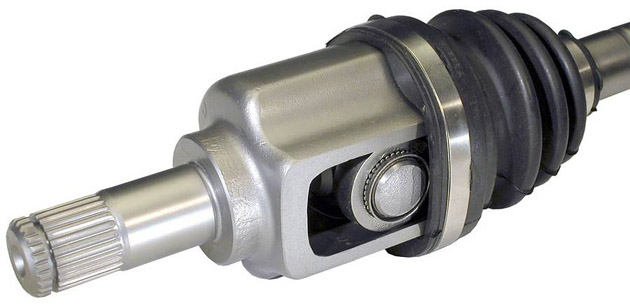Drive shafts are used to transmit power between spaced apart drive train units. They are most often used in cars with a classic design to connect the main shaft of the gearbox with the input shaft of the main transmission, which is part of the rear driving axle.
The use of rear axle suspension of the car makes, that this bridge changes its position in relation to other driving units, and therefore also in relation to the gearbox. It is therefore essential to use shaft joints. Thanks to the use of articulated joints, changes in the angle between the shaft axis and the axis of the main shaft of the gearbox and the angle between the shaft axis and the axis of the attacking shaft of the main gear do not bend the shaft.
Drive shaft with universal joints. The shaft is made of a thin-walled steel tube and ends on both sides with joint forks. While the car is moving, changes in the position of the rear axle cause slight changes in the distance between the joints of the shaft. It is therefore necessary to use a spline connection at one of the shaft ends. This connection is periodically filled with grease and sealed with a gasket.
As a rule, universal joints are used in drive shafts.  The cross is gripped by a pair of forks, some of which are associated with a drive shaft, and the second - with a driven shaft. Such a connection makes it possible to transfer the torque from the driving shaft to the driven shaft, although the shaft axes are at an angle to each other.
The cross is gripped by a pair of forks, some of which are associated with a drive shaft, and the second - with a driven shaft. Such a connection makes it possible to transfer the torque from the driving shaft to the driven shaft, although the shaft axes are at an angle to each other.
A single universal joint does not provide uniform speed transmission; the driven shaft spins unevenly, feeling "jerks" with each turn. In order to obtain a smooth running it is necessary to use two joints with such an arrangement, that the shaft-coupled forks of joints are in the same plane.
Sometimes the distance between the coupled driveline units is too great, that the single-section shaft is sufficiently stiff. Then a double shaft is used, supported indirectly in an additional bearing. The first section of the shaft is devoid of universal joints, because a flexible second joint and a flexible support bearing suspension are sufficient to accommodate the slight movements of the gearbox flexibly suspended in the car. The second section of the shaft, connected to the drive axle, has two universal joints, however, there is no spline connection, used in a part of the shaft.